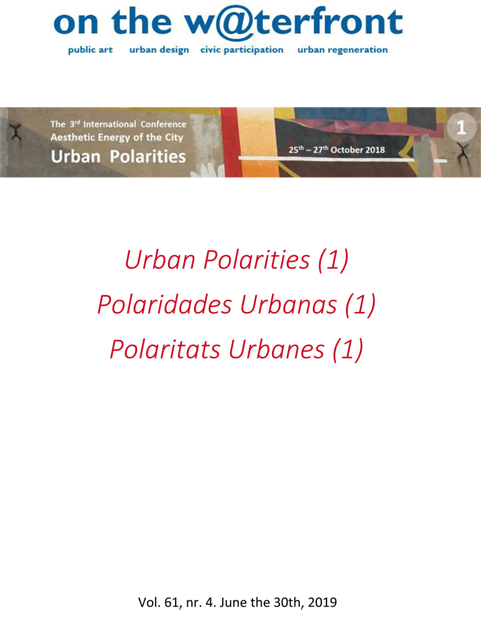‘Welcome signs’ in public space: separation and identity
DOI:
https://doi.org/10.1344/waterfront2019.61.6.4Keywords:
place marketing, visual identity, signage, public spaceAbstract
Purpose – The main purpose of this paper is to present researches on the ‘welcome signs’ as a symbolic elements in territorial representation, which have at least two meanings: symbolic disclosing identity of a particular place and spatial being an element of certain public pace. Therefore, the second objective is to define the value of such visual signs in branding strategy of a place.
Methodology/approach – The research take advantage of the content analysis of signs to make conclusions referring to the communications process and place marketing concepts.
Findings – ‘Welcome signs’ are symbolic installations, which are kind of testimonials about particular places. Apart from the role of identification, information and advertising, these signs have also aesthetic significance as well as they are spatial forms of territorial division.
Practical implications – The ‘welcome signs’ are made in intuitive ways by the legitimate authorities, so the examination of them and building a model of their content and design might be very beneficial and helpful for LGU.
Originality – So far, welcome signs have not been particularly the subjects of marketing, social or political researches.
References
ADAMUS-MATUSZYŃSKA, ANNA, and PIOTR DZIK: Tożsamość wizualna polskich województw, miast i powiatów. Identyfikacja, prezentacja, znaczenie. Katowice, Toruń: ASP w Katowicach, Wydawnictwo Adam Marszałek, 2017.
BELTING, HANS: Antropologia obrazu. Szkice do nauki o obrazie. Translated by Mariusz Bryl. Kraków: Universitas, 2012.
BOURDIEU, PIERRE Language and Symbolic Power, Polity Press, Cambridge, 1991.
CHERNATONY, LESLIE DE; MCDONALD, MALCOLM, and WALLACE, ELAINE. Creating Powerful Brands. London: Routledge, 2013.
CLEEREMANS, AXEL A.: Mechanisms of implicit learning: A connectionist model of sequence processing. MIT Press, Cambridge, USA, 1993.
GIBBS, DAVID. “See how you feel,” in ANGUS HYLAND and STEVEN BATEMAN, Symbol. The reference guide to abstract and figurative trademarks. London: Laurence King, 2014.
GOŹLIŃSKA, KAROLINA (Ed.), Biblioteka wizerunku miasta. Część 1 – miejskie powitanie. Warszawa, AMS, 2013.
KAPFERER, JEAN-NOËL: The New Strategic Brand Management. Creating and Sustaining Brand Equity Long Term. London & Philadelphia: Kogan Page, 2008.
KISZLUK, GRZEGORZ: „Witacz jako wizytówka”, [in:] Biblioteka wizerunku miasta, AMS, Warszawa, p. 2012, 17-21.
KOTLER PHILIP, HAIDER D.H., REIN I.: Marketing Places. Attracting Investment, Industry, and Tourism to Cities, States and Nations, The Free Press, Nowy Jork, 1993.
LYNCH, KEVIN: The Image of the City. Cambridge: Mit Press, 1960
MAIGRET ERIC, Socjologia komunikacji i mediów. Oficyna Naukowa, Warszawa 2012
MOLLERUP, PER: Marks of Excellence. London: Phaidon Press, 2013
MOLLERUP, PER. Wayshowing>Wayfinding. Basic & Interactive. Amsterdam: BIS Publishers, 2013.
AGNIESZKA OGONOWSKA: Przemoc ikoniczna. Zarys wykładu. Wydawnictwo Naukowe Akademii Pedagogicznej, Kraków, 2004.
OLINS, WALLY. Wally Olins: The Brand Handbook. London: Thames & Hudson, 2008.
ROSE, GILLIAN: Interpretacja materiałów wizualnych. Krytyczna metodologia badań nad wizualnością, Wydawnictwo Naukowe PWN, Warszawa, 2010.
SCHMITT BRAND, SIMONSON ALEX: Estetyka w marketingu. Strategiczne zarządzanie markami, tożsamością i wizerunkiem firmy, Wydawnictwo Profesjonalnej Szkoły Biznesu, Kraków, 1997.
WHEELER, ALINA. Designing Brand Identity. An essential guide for the whole branding team. Hoboken: Wiley & Sons, 2018.
WISMER, ANDREW J.; BOHIL, COREY J.: Base-rate sensitivity through implicit learning. „PLOS One”, https://doi.org/10.1371/journal.pone.0179256, 2017.
VELA JORDI DE SAN EUGENIO, JOAN NOGUE, ROBERT GOVERS, Visual landscape as a key element of place branding. “Journal of Place Management and Development”, vol. 10, no. 1, 2017.
VUIGNIER, RENAUD. „Place branding & place marketing 1976-2016: A multidisciplinary literature review,” International Review on Public and Nonprofit Marketing, 14, issue 4 (Dec. 2017), p. 447-473
ZNAMIEROWSKI, ALFRED. Heraldyka i weksylologia. Warszawa: Arkady, 2017
PRAWO AUTORSKIE (Author’s Law) http://isap.sejm.gov.pl/isap.nsf/DocDetails.xsp?id=WDU19940240083
Downloads
Published
How to Cite
Issue
Section
License
The
 licence allows: Share — copy and redistribute the material in any medium or format and Adapt — remix, transform, and build upon the material for any purpose, even commercially.The licensor cannot revoke these freedoms as long as you follow the license terms. Author's rights are protected by the ISSN 1139-7365. On the w@terfront has no restrictions respect the copyright by the authors and does allow authors to retain the publishing rights without restrictions.
licence allows: Share — copy and redistribute the material in any medium or format and Adapt — remix, transform, and build upon the material for any purpose, even commercially.The licensor cannot revoke these freedoms as long as you follow the license terms. Author's rights are protected by the ISSN 1139-7365. On the w@terfront has no restrictions respect the copyright by the authors and does allow authors to retain the publishing rights without restrictions.This journal does not apply any type of charge to the authors for the presentation or processing of the articles.







